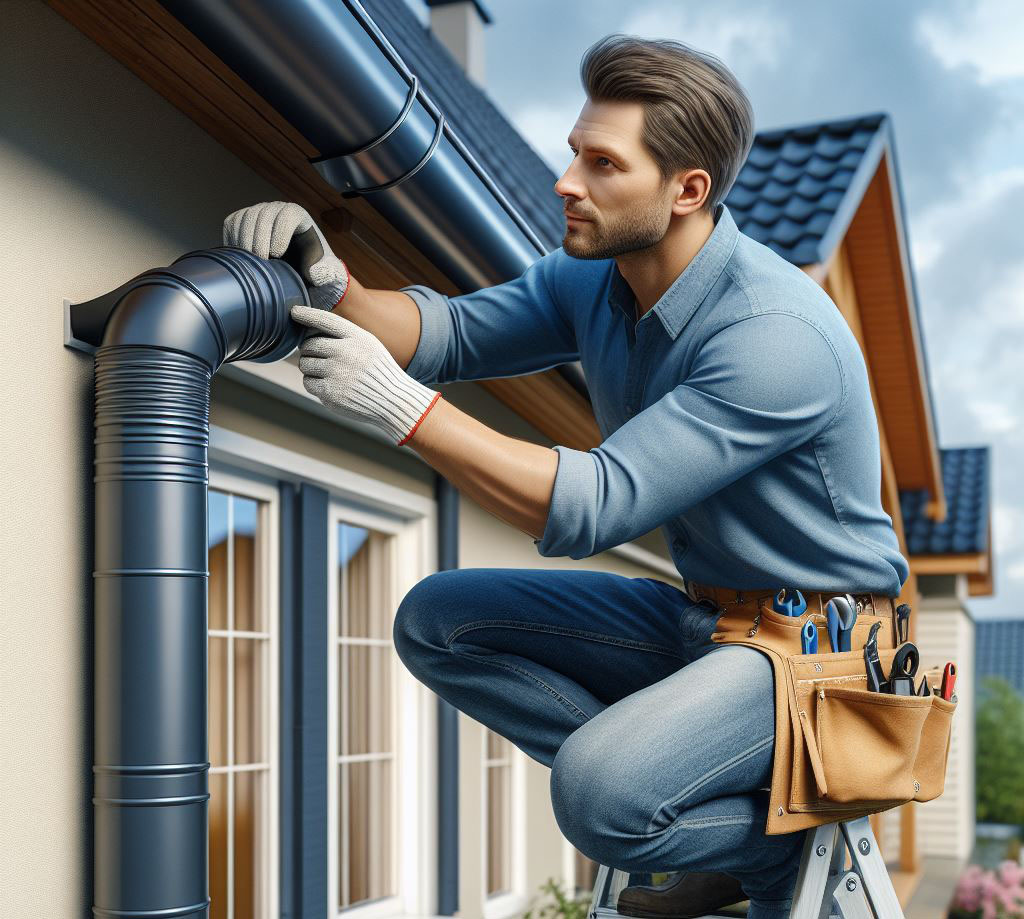Welcome to the world of gutter drain pipes – an essential component in safeguarding your home from water’s wear and tear. Whether you’re a skilled handyman, a self-employed contractor, or simply passionate about home repairs, understanding the ins and outs of gutter drain pipes is crucial. In my many years in construction and renovation, I’ve seen the havoc that water can wreak on a house. Trust me, a little knowledge and the right approach to gutters can save you from a world of trouble down the road.

Understanding Gutter Drain Pipes
Let’s start with the basics. Gutter drain pipes are your first line of defense against rainwater. They channel water away from your home, thereby protecting your foundation, preventing soil erosion, and keeping water out of your basement. But not all gutter pipes are created equal.
You’ll find them in various materials. PVC is popular for its affordability and ease of installation. It’s a good pick for mild climates but can become brittle in extreme cold. Aluminum is a step up—lightweight, rust-resistant, and able to withstand colder climates. For a more traditional or upscale look, copper is a great choice. It’s durable and develops a beautiful patina over time.
Why does this matter? Imagine you’ve just finished a beautiful kitchen remodel. You’ve got the perfect cabinets, a gleaming countertop, but then a storm hits and your basement floods because your gutters couldn’t handle the runoff. Or worse, water seeps into your new kitchen. That’s why understanding gutter drain pipes is so crucial.
Selection Criteria for Gutter Drain Pipes
Picking the right gutter drain pipe isn’t just about aesthetics, it’s about functionality and durability. Here are some key considerations:
- Size and Capacity: Consider the size of your roof and the average rainfall in your area. A larger or steeper roof will require a gutter system that can handle more water.
- Material Selection: Weigh the pros and cons of different materials. PVC is cost-effective and easy to work with but may not endure extreme weather. Aluminum is more resilient and versatile. Copper is top-of-the-line in both looks and longevity but comes with a higher price tag.
- Climate Compatibility: Your local weather plays a crucial role. In areas with heavy snowfall, you need gutters that can support the weight of the snow and ice. In hotter climates, materials that can withstand high temperatures are essential.
- Aesthetics and Integration: Your gutter system should complement your home’s exterior. Today, there are numerous styles and colors to choose from, allowing you to enhance your home’s appearance while ensuring effective water drainage.
Installation Basics
Installing gutter drain pipes might seem daunting, but with the right approach, it’s a task any dedicated DIYer can handle. Let me walk you through the process, step-by-step, to ensure a smooth and efficient installation.
- Assembling Your Toolkit: First things first, gather your tools. You’ll need a reliable ladder, a drill, handsaw or tin snips for metal gutters, a rivet gun, silicone sealant, a tape measure, and your gutter components. Don’t forget safety gear like gloves and goggles. Safety is paramount, so ensure your ladder is stable and you’re comfortable working at height.
- Accurate Measurements: Measure the length of your roof’s edge where you’ll be installing the gutters. A key point is ensuring a slight slope towards the downspout, about 1/16 inch per foot, to facilitate proper drainage.
- Bracket Installation: Securely fasten the brackets to your fascia board at regular intervals, roughly every two feet. This spacing ensures that your gutter will have the necessary support.
- Fitting the Gutter Sections: Slide your gutter sections into the brackets. If you’re working with PVC, be careful not to over-tighten and crack the material. For metal gutters, ensure the ends are neatly cut and filed to avoid sharp edges.
- Sealing and Joining: When connecting gutter sections, use your rivet gun for a firm join and apply silicone sealant for a watertight seal. Overlapping the sections slightly will help prevent leaks.
- Downspout Installation: Mark and cut out the hole for the downspout in the gutter. Attach the outlet and then secure the downspout sections with screws and brackets. Ensure the downspout directs water well away from your foundation to prevent any potential water damage.
- Inspection: After installation, inspect the entire system. Make sure all parts are securely fastened and the gutters have the correct slope towards the downspouts.

Downspout Extension Ideas and Innovations
Downspouts are often seen purely as functional elements, but they offer an opportunity to add aesthetic value to your home. Here are some creative ideas:
- Decorative Splash Blocks: A great way to add a bit of character. Choose designs that complement your home’s style while effectively directing water away from the foundation.
- Rain Chains: These are not only visually appealing but also create a calming sound during rainfall. They can be a stylish alternative to traditional downspouts.
- Planter Integration: For the green-thumbed, incorporating planters into your downspout design can enhance your home’s greenery. Ensure proper water management to maintain structural integrity.
- Underground Drain Pipes: If visible downspouts aren’t your thing, consider an underground drainage system. It can be a discreet yet effective way to manage rainwater.
- Custom Colors and Materials: Tailor your downspouts to complement your home’s design. Whether it’s matching the color palette or choosing materials that accentuate your home’s architecture, the right choice can elevate the overall look.
Maintenance and Troubleshooting
Maintaining gutter drain pipes isn’t just about keeping them clean, it’s about ensuring the longevity and functionality of your home’s drainage system. From my years in the field, I’ve learned that a little attention goes a long way in preventing bigger problems down the road. Here’s what you need to know:
- Routine Maintenance Tips:
- Regular Cleaning: Clean your gutters at least twice a year – in the spring and fall. Removing leaves, twigs, and debris is crucial to prevent clogging and water overflow.
- Inspection for Damage: Look for any signs of wear and tear, such as cracks, rust, or holes. Small issues can be addressed with roofing cement and a basic patch kit.
- Alignment Check: Make sure your gutters are properly aligned with a slight slope towards the downspouts for efficient water flow.
- Fixing Common Issues:
- Clogs: A clogged gutter can cause significant water damage. Clear out any blockages by hand, and consider installing gutter guards to minimize future clogs.
- Leaks and Holes: For small leaks, apply gutter sealant. Larger holes may require a patch or a replacement section.
- Sagging Gutters: This often indicates that the gutter hangers are spaced too far apart or are failing. Adding or replacing hangers can remedy this problem.
- When to Call a Professional:
If the issues are beyond basic fixes or if working at heights is not within your comfort zone, it’s wise to seek the expertise of a professional gutter service.
FAQ Section
It’s best to clean your gutters twice a year. If you live in an area with many trees, you might need to clean them more frequently. Regular cleaning prevents clogs, which can lead to water damage.
Gutter installation can be a DIY project if you’re comfortable with basic tools and heights. However, for complex installations or safety concerns, hiring a professional is recommended.
In heavy rainfall areas, durable materials like aluminum or steel are advisable. They are designed to withstand substantial water flow and resist weathering.
Keep your gutters clean to prevent water accumulation. Installing heating cables can also prevent freezing. Ensuring your attic is properly insulated helps maintain even temperatures along your roofline.
Yes, look for gutters made from recycled materials. Options like copper are both durable and recyclable. Additionally, consider installing a rain barrel to collect and reuse water for your garden.
